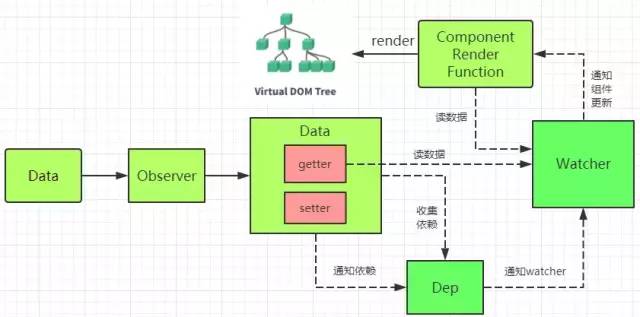vue2源码简单实现stage4
上一节我们已经实现了diff和比较两个vnode之后手动更新视图,这一节我们除了要给数据进行proxy劫持之外,还要给数据添加watcher,监听数据改变时更新视图。下面是响应式原理的图解:

;(function () {
function defineReactive (obj, key, val) {
var dep = new Dep(); // 每首歌数据添加一个dep对象
Object.defineProperty(obj, key, {
get: function () {
//注意的是在数据初始化阶段,依赖并没有收集,mount时候将数据的watcher添加到dep队列里面
if (Dep.target) {
Dep.target.addDep(dep);
}
return val
},
set: function (newVal) {
if (newVal === val) return;
val = newVal;
dep.notify();
}
})
}
function observe (obj) {
for (var key in obj) {
defineReactive(obj, key, obj[key])
}
}
var uid$1 = 0;
function Dep () {
this.subs = [];
this.id = uid$1++;
}
Dep.target = null;
Dep.prototype.addSub = function (sub) {
this.subs.push(sub)
}
Dep.prototype.notify = function () {
var subs = this.subs;
for (var i = 0, l = subs.length; i < l; i++) {
subs[i].update()
}
}
function Watcher (vm, expOrFn, cb) {
this.vm = vm;
this.getter = expOrFn;
this.cb = cb;
this.depIds = [];
this.value = this.get();
}
Watcher.prototype.get = function () {
//将watcher赋值给Dep.target一个全局变量,这是为了在依赖收集阶段做的准备。
Dep.target = this; /* ! */
var value = this.getter.call(this.vm);
Dep.target = null;
return value
}
Watcher.prototype.update = function () {
var value = this.get();
if (this.value !== value) {
var oldValue = this.value;
this.value = value;
this.cb.call(this.vm, value, oldValue);
}
}
Watcher.prototype.addDep = function (dep) {
var id = dep.id;
// to avoid depending the watcher to the same dep more than once
if (this.depIds.indexOf(id) === -1) {
this.depIds.push(id);
dep.addSub(this);
}
}
function vnode (tag, data, children, text, elm) {
this.tag = tag;
this.data = data;
this.children = children;
this.text = text;
this.elm = elm;
}
function normalizeChildren (children) {
if (typeof children === 'string') {
return [createTextVNode(children)]
}
return children
}
function createTextVNode (val) {
return new vnode(undefined, undefined, undefined, String(val))
}
function createElement (tag, data, children) {
return new vnode(tag, data, normalizeChildren(children), undefined, undefined);
}
function createElm (vnode) {
var tag = vnode.tag;
var data = vnode.data;
var children = vnode.children;
if (tag !== undefined) {
vnode.elm = document.createElement(tag);
if (data.attrs !== undefined) {
var attrs = data.attrs;
for (var key in attrs) {
vnode.elm.setAttribute(key, attrs[key])
}
}
if (children) {
createChildren(vnode, children)
}
} else {
vnode.elm = document.createTextNode(vnode.text);
}
return vnode.elm;
}
function createChildren (vnode, children) {
for (var i = 0; i < children.length; ++i) {
vnode.elm.appendChild(createElm(children[i]));
}
}
function sameVnode (vnode1, vnode2) {
return vnode1.tag === vnode2.tag
}
function emptyNodeAt (elm) {
return new vnode(elm.tagName.toLowerCase(), {}, [], undefined, elm)
}
function patchVnode (oldVnode, vnode) {
var elm = vnode.elm = oldVnode.elm;
var oldCh = oldVnode.children;
var ch = vnode.children;
if (!vnode.text) {
if (oldCh && ch) {
updateChildren(oldCh, ch);
}
} else if (oldVnode.text !== vnode.text) {
elm.textContent = vnode.text;
}
}
function updateChildren (oldCh, newCh) {
// assume that every element node has only one child to simplify our diff algorithm
if (sameVnode(oldCh[0], newCh[0])) {
patchVnode(oldCh[0], newCh[0])
} else {
patch(oldCh[0], newCh[0])
}
}
function patch (oldVnode, vnode) {
var isRealElement = oldVnode.nodeType !== undefined; // virtual node has no `nodeType` property
if (!isRealElement && sameVnode(oldVnode, vnode)) {
patchVnode(oldVnode, vnode);
} else {
if (isRealElement) {
oldVnode = emptyNodeAt(oldVnode);
}
var elm = oldVnode.elm;
var parent = elm.parentNode;
createElm(vnode);
parent.insertBefore(vnode.elm, elm);
parent.removeChild(elm);
}
return vnode.elm
}
function initData (vm) {
var data = vm.$data = vm.$options.data;
var keys = Object.keys(data);
var i = keys.length
// proxy data so you can use `this.key` directly other than `this.$data.key`
while (i--) {
proxy(vm, keys[i])
}
// 初始化的时候给每个数据添加一个dep对象
observe(data)
}
function proxy (vm, key) {
Object.defineProperty(vm, key, {
configurable: true,
enumerable: true,
get: function () {
return vm.$data[key]
},
set: function (val) {
vm.$data[key] = val
}
})
}
function Vue (options) {
var vm = this;
vm.$options = options;
initData(vm);
vm.mount(document.querySelector(options.el))
}
Vue.prototype.mount = function (el) {
var vm = this;
vm.$el = el;
// // 在组件实例生命周期的挂载阶段。可以看到Watcher被创建
new Watcher(vm, function () {
vm.update(vm.render());
});
}
Vue.prototype.update = function (vnode) {
var vm = this;
var prevVnode = vm._vnode;
vm._vnode = vnode;
if (!prevVnode) {
vm.$el = vm.patch(vm.$el, vnode);
} else {
vm.$el = vm.patch(prevVnode, vnode);
}
}
Vue.prototype.patch = patch;
Vue.prototype.render = function () {
var vm = this;
return vm.$options.render.call(vm)
}
var vm = new Vue({
el: '#app',
data: {
message: 'Hello world',
isShow: true
},
render () {
return createElement(
'div',
{
attrs: {
'class': 'wrapper'
}
},
[
this.isShow
? createElement(
'p',
{
attrs: {
'class': 'inner'
}
},
this.message
)
: createElement(
'h1',
{
attrs: {
'class': 'inner'
}
},
'Hello world'
)
]
)
}
})
// test
setTimeout(function () {
vm.message = 'Hello';
}, 1000)
setTimeout(function () {
vm.isShow = false;
}, 2000)
})();
依赖在哪里收集,如何收集
1.依赖收集在组件渲染阶段,当组件需要用到(touch)数据时,通过获取前面数据监听定义的值在getter阶段收集依赖。
2.dep是一个依赖收集器,将依赖收集起来,然后在数据变化时通知每个watcher。
疑问点,为什么在getter阶段运行dep.depend(),而不是在创建完watcher后可以在任意地方运行将此收集起来,然后等到数据发生变化时通知wathcer。
如果可以在任意地方收集,则dep的subs成员需要是全局对象,这样当某个数据变化后将会通知所有的watcher,这是不合理的。正确的做法是每个数据属性都有对应得一个Dep依赖收集器,收集相关的watcher。因此只能在getter阶段运行dep.depend(),从设计逻辑上订阅(touch)某个数据的时候才开始收集依赖才是合理的。那么能不能在watcher创建给 Dep.target赋值后,使用obj.defindProperty劫持对象属性呢?显然也是不现实的,当其它Watcher依赖当前data属性时也需要重新重写getter/setter,这会覆盖原来的dep。Data和watcher之间的关系是一对多的依赖关系,而不是一对一。


